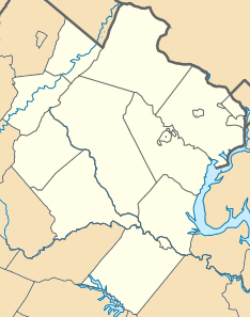Franklin and Armfield Office
|
Franklin and Armfield Office | |
|
Freedom House | |
    | |
| Location | Alexandria, Virginia |
|---|---|
| Coordinates | 38°48′14″N 77°3′17″W / 38.80389°N 77.05472°WCoordinates: 38°48′14″N 77°3′17″W / 38.80389°N 77.05472°W |
| Area | 27 acres (11 ha) |
| Built | 1810 |
| Architect | Robert Young |
| Architectural style | Federal, Other |
| NRHP Reference # | 78003146 |
| VLR # | 100-0105 |
| Significant dates | |
| Added to NRHP | June 2, 1978[1] |
| Designated NHL | June 2, 1978[2] |
| Designated VLR | October 16, 1979[3] |
The Franklin and Armfield Office, now known as the Freedom House Museum, is a historic commercial building at 1315 Duke Street in Alexandria, Virginia. Built c. 1810-20, it housed the offices of the largest slave trading firm in the antebellum south, started in 1828 by Isaac Franklin and John Armfield. It was designated a National Historic Landmark in 1978. The Freedom House Museum is owned by the Northern Virginia Urban League, with exhibits about the building's slave trading history and the life of a slave.[4][5]
Description and history
The former Franklin and Armfield Office building is located just west of Alexandria's Old Town, on the north side of Duke Street between South West and South Payne Streets. It is a three story brick building, topped by a mansard roof and resting on a brick foundation. Its front facade is laid in Flemish bond, while the sides and rear are laid in common bond. It has Federal period styling, with windows and the entrance door set in segmented, arch openings, with gabled dormers at the roof level.[6]
The building was constructed as a residence sometime in the 1810s by Robert Young, a brigadier general in the District of Columbia militia. Due to financial reverses, Young was soon afterward forced to sell the house. It was purchased in 1828 by Isaac Franklin and John Armfield, who established it as their Washington-area office, and the residence of Armfield. The property then extended further east, and included buildings for holding and trading in slaves. The two-story extension to the rear of this house was part of the slave-holding facilities, which included high walls, and interior chambers that featured prison-like grated doors and windows. Armfield sold the property to another slave trader in 1836, and it continued to be used as a slave trading site until Alexandria fell to Union Army forces early in the American Civil War.[6] The Union used the property to imprison Confederate soldiers.

After the war, the outlying slave pens were torn down, the brick possibly reused in the construction of the adjacent townhouses.[6] After serving a variety of other uses, it now houses a museum devoted to the slave trade.
See also
- List of National Historic Landmarks in Virginia
- National Register of Historic Places listings in Alexandria, Virginia
References
- ↑ National Park Service (2008-04-15). "National Register Information System". National Register of Historic Places. National Park Service.
- ↑ "Franklin & Armfield Office". National Historic Landmark summary listing. National Park Service. Retrieved 2008-06-26.
- ↑ "Virginia Landmarks Register". Virginia Department of Historic Resources. Retrieved 2013-05-12.
- ↑ "Freedom House Museum". The Smithsonian Associates. Retrieved 5 October 2015.
- ↑ "Alexandria museum of slave trade damaged by winter storms". The Washington Post. March 4, 2015. Retrieved 5 October 2015.
- 1 2 3 "NHL nomination for Franklin and Armfield Office" (PDF). National Park Service. Retrieved 2016-01-26.

